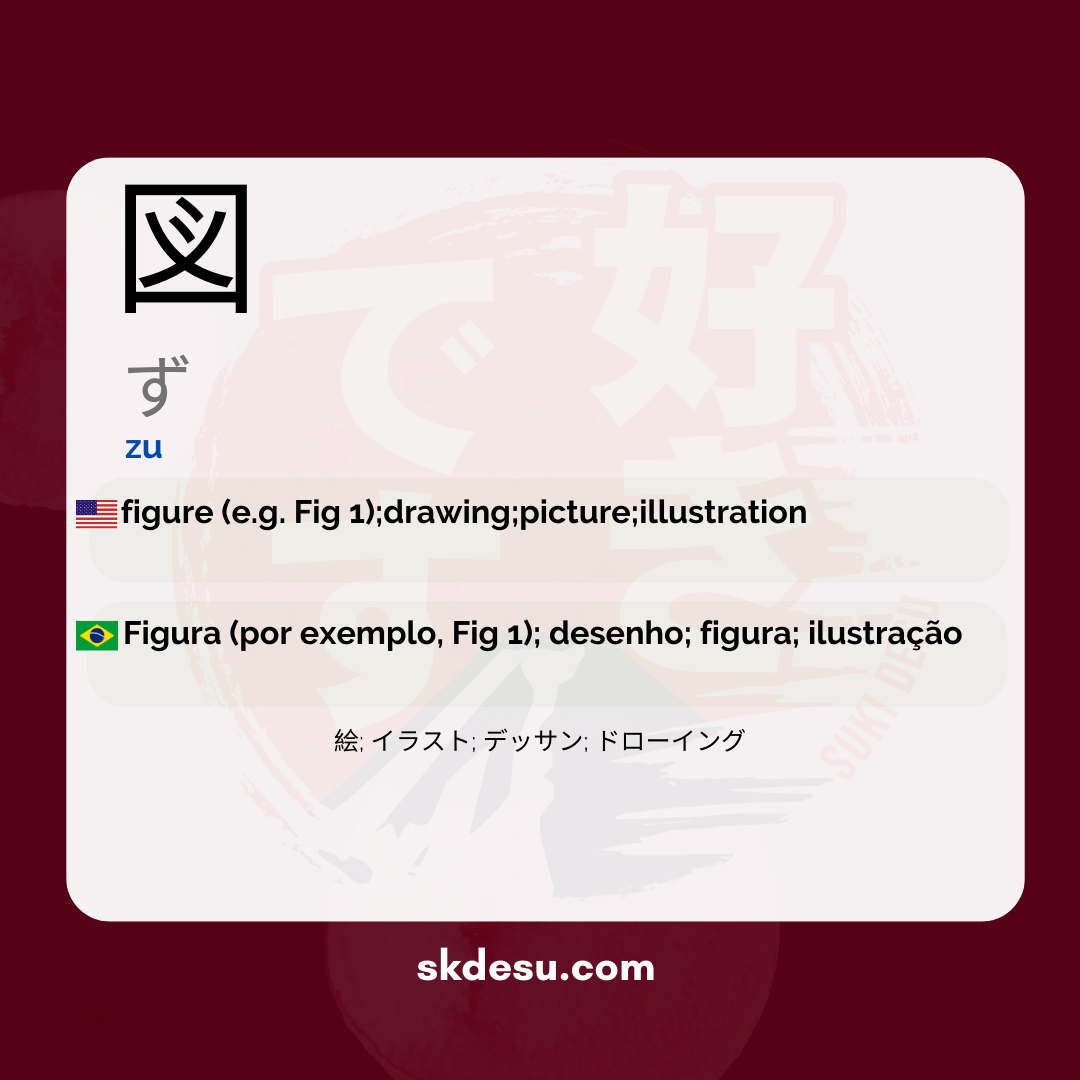Translation and Meaning of: 図 - zu
The Japanese word 図 (ず) is a versatile term often used in daily life, but it can raise questions for language learners. In this article, we will explore its meaning, origin, and practical uses, along with curiosities about how it appears in Japanese culture. If you've ever wondered how to memorize this kanji or in what contexts it is used, keep reading to find out!
In the Suki Nihongo dictionary, 図 is defined as "diagram," "map," or "plan," but its use goes beyond these literal translations. It also appears in compound expressions and has a significant presence in written materials, from books to informational signs. Let’s uncover all these details below.
Meaning and use of 図 (ず)
The kanji 図 carries the idea of visual representation, being used to refer to diagrams, charts, and schematics. In Japanese, it can appear alone or as part of more complex words, such as 地図 (ちず - map) or 図書館 (としょかん - library). Its meaning is closely related to the organization of information in a clear and accessible way.
In everyday life, it is common to find 図 in instruction manuals, textbooks, and even in work presentations. A simple example is the phrase この図を見てください (Please look at this diagram), often used in educational or professional contexts. This versatility makes it an essential word for those studying Japanese.
Origin and writing of the kanji 図
The origin of 図 dates back to ancient Chinese, where the character represented the idea of "planning" or "drawing." It is composed of the radical 囗 (which symbolizes a boundary or outline) and the component 啚 (which reinforces the notion of delimitation). This combination accurately reflects the concept of creating visual representations within a defined space.
To memorize the writing of this kanji, a useful tip is to associate its shape with a "frame that contains information." The outer part (囗) resembles a frame, while the inner strokes suggest details being organized. This visual technique helps many students to retain the character more easily.
Curiosities and expressions with 図
An interesting fact about 図 is its presence in Japanese proverbs, such as 図に乗る (ずにのる), which means "to become arrogant" or "to overestimate oneself." This expression illustrates how the term can take on abstract meanings, going beyond the literal sense of "diagram."
In pop culture, 図 frequently appears in manga and anime that involve strategic settings or technical explanations. Characters who devise complex plans are often shown alongside 図 filled with notes, reinforcing the association between the kanji and the act of planning.
Vocabulary
Expand your vocabulary with related words:
Synonyms and similar words
- 絵 (e) - Painting or image in general.
- イラスト (irasuto) - Illustration, generally used in books and magazines.
- デッサン (dessan) - Drawing, especially an artistic sketch.
- ドローイング (dorōingu) - Drawing, often referring to the drawing technique in general.
Related words
Romaji: zu
Kana: ず
Type: noun
L: jlpt-n3
Translation / Meaning: Figure (eg Fig 1); design; figure; illustration
Meaning in English: figure (e.g. Fig 1);drawing;picture;illustration
Definition: A means of drawing or displaying images or diagrams.
Quick Access
- Vocabulary
- Writing
- Sentences
How to Write in Japanese - (図) zu
See below a step-by-step guide on how to write the word by hand in Japanese. (図) zu:
Example Sentences - (図) zu
See below some example sentences:
Watashi wa ashita toshokan kara hon wo kariru yotei desu
I plan on borrowing a book from the library tomorrow.
I plan to rent a book from the library tomorrow.
- 私 (watashi) - Japanese personal pronoun that means "I"
- は (wa) - topic particle that indicates the topic of the sentence, in this case, "I"
- 明日 (ashita) - Japanese adverb that means "tomorrow"
- 図書館 (toshokan) - Japanese noun meaning "library"
- から (kara) - particle indicating the origin or starting point, in this case, "from the library"
- 本 (hon) - Japanese noun meaning "book"
- を (wo) - direct object particle indicating the object of the action, in this case, "book"
- 借りる (kariru) - Japanese verb meaning "to lend"
- 予定 (yotei) - Japanese noun meaning "plan" or "schedule"
- です (desu) - linking verb that indicates formality and courtesy in the Japanese language
Watashi wa toshokan kara hon o karimashita
I borrowed a book from the library.
I borrowed a book from the library.
- 私 (watashi) - personal pronoun that means "I"
- は (wa) - grammatical particle that indicates the topic of the sentence
- 図書館 (toshokan) - noun meaning "biblioteca"
- から (kara) - grammatical particle that indicates origin or starting point
- 本 (hon) - noun meaning "book"
- を (wo) - grammatical particle that indicates the direct object of the sentence
- 借りました (karimashita) - "borrowed"
Watashi no ito wa meikaku desu
My intention is clear.
- 私 - Personal pronoun "I" in Japanese.
- の - Possessive particle in Japanese, equivalent to "de" in Portuguese.
- 意図 - 名詞は日本語で「意図」または「目的」を意味します。
- は - Topic particle in Japanese, which indicates the subject of the sentence.
- 明確 - 明らかな (akirakana)
- です - Verb "to be" in Japanese, used to affirm or confirm something.
Kashidashi wa toshokan de dekimasu
You can rent it from the library.
- 貸し出し - loan
- は - Topic particle
- 図書館 - library
- で - Location particle
- できます - can be done
Other Words of this Type: noun
See other words from our dictionary that are also: noun

